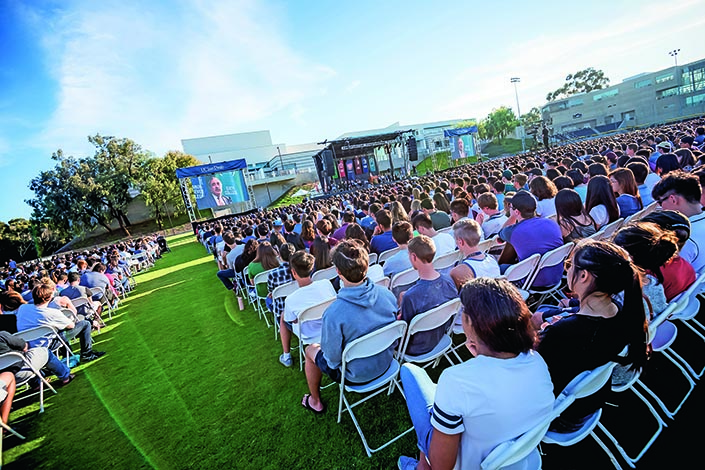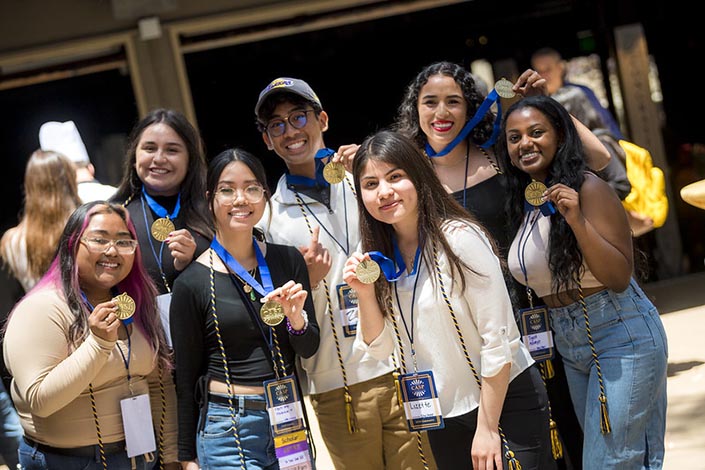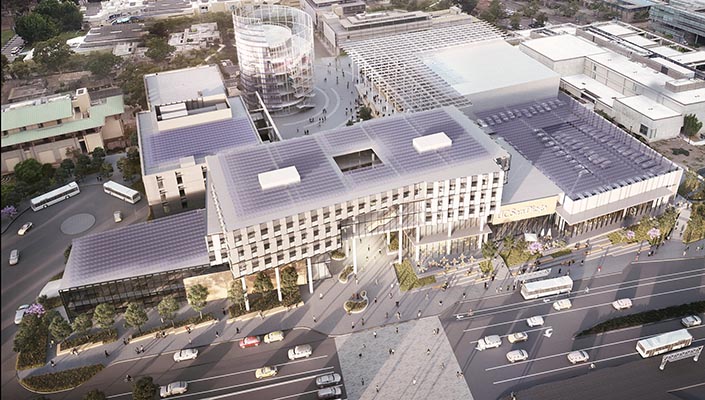Decade of Leadership
A conversation with UC San Diego's chancellor
Published Date
Story by:
Topics covered:
Share This:
Article Content
This story was published in the Fall 2022 issue of UC San Diego Magazine
Pradeep K. Khosla, UC San Diego’s eighth chancellor, is the dedicated steward of the 62-year-old institution.
He recently announced the close of Campaign for UC San Diego, an ambitious 10-year, $2 billion capital fundraising campaign. It exceeded all expectations, raising $3.05 billion, surpassing the original goal by more than $1 billion, making UC San Diego the youngest institution ever to complete a multi-billion-dollar fundraising campaign. UC San Diego Magazine sat down with the 63-year-old Chancellor Khosla to reflect on the last decade under his leadership—and what’s next for this visionary leader.
It’s been 10 years since you last spoke with UC San Diego magazine. How have you changed?
When I arrived at UC San Diego, I was anxious and impatient to get things done. The first thing I implemented was a strategic planning process, which took longer than I expected… 18 months. But that taught me patience, and if one is more patient, one can get much more done. Through the strategic planning process, we sharpened our mission to be a student-centered, research-focused, and service-oriented public university. Every decision we make is based around these words.
How would you describe today’s UC San Diego student?
I think today’s student is more socially awake. They are more aware of the impact their lifestyle has on the planet and communities around them. They are more focused on equity and the just treatment of others. That’s not to say the generations of the past were not socially responsible, but these students demonstrate it in a slightly more self-sacrificing way where they’re willing to give up a little bit of their own social comforts for the greater good.
After 10 years, what are you most proud of?
Today, I’m most proud of the physical, cultural and intellectual transformation of campus. We typically talk about the physical transformation because we can see the buildings… but I can tell you that it’s the cultural and intellectual transformation that precipitates (or forces) the physical change to occur. There’s something special happening inside these buildings.

Why is it important to bring the community to campus? What do you want them to experience?
Ten years ago, the San Diego community thought we were aloof and that we wanted to remain that way. It was during my first year of meetings with local community leaders that I decided we needed to rethink that perception.
As a public institution, our main goal is to deliver education and healthcare, and build the next generation of the workforce for California. But our charter of education is more broadly defined. By inviting the community to campus, we can expose them to art and culture, perhaps awaken an inner being in them, make them more socially aware, perhaps force them to ask questions that they never would have asked. UC San Diego isn’t just a destination, but where you should also be able to engage in conversation. It’s not just my role to keep this place alive and running, but to provide access to opportunities that can enrich others intellectually.
What do you hear from our students when you are stopped on campus?
“Can I get a selfie!?” [chuckles] Overall, I sense a happier student on campus. And I feel they’re surprised to see the chancellor walking around campus, but I also think they’re happy to see me here, connecting with others rather than being a disconnected voice from a building. Sometimes I hear students talk to each other as they’re walking in front of me and they quietly try to take a photo and I tell them, “Come on guys, you want a selfie, come on over here!”
In 2013, you initiated the Chancellor’s Associates Scholarship Program (or CASP) for high-achieving, low-income students. As it nears its 10th anniversary, what does the success of CASP mean to you?
The program reflects my deep commitment to an equitable, quality education for high-achieving students who cannot afford to attend college. College has become so expensive that nearly half of families in the U.S. cannot afford it. The program also supports the whole student with access to a range of services and opportunities to ensure they thrive on campus and can fully engage in academic work, student life and university experiences. I’m really proud of this program and I’m pleased to see the donor community has been touched by it, too. I believe in these students and CASP is my way of demonstrating that commitment to them.
The Campaign for UC San Diego surpassed expectations with more than $3 billion raised—we're the youngest university to reach a multibillion fundraising goal. What’s next?

Immediately, the next thing is to say “Thank you” to our donors, because without them, we would not be where we are. When donors invest in UC San Diego, it tells me that they see potential here, perhaps a bit of their hopes and dreams for the future. As we reflect on the success of the campaign, it’s imperative that we look at what we have, what the donors have given us, and steward their contributions effectively to make us a better place than we are today.
UC San Diego Health was just named #1 in San Diego and #5 in California for the second year in a row. Can you tell me about the redevelopment of Hillcrest Medical Campus and how this will support our goal to become a destination for patients?
In 2016, we redeveloped the La Jolla Medical Campus and built the Jacobs Medical Center, which changed our ability to deliver high-quality healthcare to the community and the community’s perception of who we are and just how good we are.
In December 2021, we broke ground on a historic $3 billion redevelopment plan to reimagine the UC San Diego Health Hillcrest Medical Campus. Over the next 15 years, we will rebuild the entire Hillcrest campus to expand access to nationally ranked medical specialties and world-class patient care. By combining the strengths of the Hillcrest and La Jolla campuses, and by building accommodations near our hospitals, we want to encourage patients from around the country to seek out UC San Diego for their healthcare as the go-to place for the top medical specialties.
On the La Jolla campus, the Triton Center is finally becoming a reality. What will this new center mean for prospective students, alumni and visitors?
The Triton Center will be the hub of activity at the center of campus. It will serve as a new entrance to campus with support services for all students. It will house the Teaching + Learning Commons as well as a Student Mental Health and Wellness facility that’s fully integrated with UC San Diego Health. It will also feature a meta gallery to expose our community to cutting-edge art that integrates augmented reality, virtual reality and physical art, all in one space. I hope it will inspire the next iteration of education through arts and culture.
As part of the Triton Center, there’s also the long-awaited Alumni Center.

Yes, the Alumni Center! The design is outstanding: It is shaped like a beacon, a welcome light to guide alumni home. It will serve as a meeting place for alumni, students and members of the community. We also hope to capture the history of UC San Diego and the significant contributions of our alumni, now numbering more than 226,000 worldwide.
In 2012, the question from the editor was: What will UC San Diego be like in five to seven years? You replied, “There is a difference between what our impact is, and what the perception of our impact is.” Do you think the campus has demonstrated its impact over the last 10 years?
I think we’ve come closer. We developed a strategic plan, we ranked higher in rankings across the board… but does the community—as in a broadly defined national and international community—clearly understand our capabilities and the impact we are making? No. They understand more than they did in 2012, but less than they should, in my opinion.
I can think of many areas where we can excel in the future. I like to look at where the world is going, where our faculty are going, collect input broadly from our faculty and scholars and use that to position ourselves. Why? It doesn’t matter what I decide… if people don’t believe in it, we’ll never get there. I can imagine a lot of good work, especially with the university’s research portfolio. Simply put: The future is for us to define.
You May Also Like
Stay in the Know
Keep up with all the latest from UC San Diego. Subscribe to the newsletter today.





